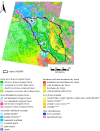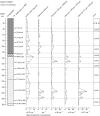Long-term forest-savannah dynamics in the Bolivian Amazon: implications for conservation
- PMID: 17255037
- PMCID: PMC2311431
- DOI: 10.1098/rstb.2006.1987
Long-term forest-savannah dynamics in the Bolivian Amazon: implications for conservation
Abstract
The aim of this paper is to evaluate the respective roles of past changes in climate, geomorphology and human activities in shaping the present-day forest-savannah mosaic of the Bolivian Amazon, and consider how this palaeoecological perspective may help inform conservation strategies for the future. To this end, we review a suite of palaeoecological and archaeological data from two distinct forest-savannah environments in lowland Bolivia: Noel Kempff Mercado National Park (NKMNP) on the Precambrian Shield and the 'Llanos de Moxos' in the Beni basin. We show that they contain markedly contrasting legacies of past climatic, geomorphic and anthropogenic influences between the last glacial period and the Spanish Conquest. In NKMNP, increasing precipitation caused evergreen rainforest expansion, at the expense of semi-deciduous dry forest and savannahs, over the last three millennia. In contrast, pre-Hispanic indigenous cultures were instrumental in facilitating recent forest expansion in the Llanos de Moxos by building a vast network of earthworks. Insights from Mid-Holocene palaeodata, together with ecological observations and modelling studies, suggest that there will be progressive replacement of rainforest by dry forest and savannah in NKMNP over the twenty-first century in response to the increased drought predicted by general circulation models. Protection of the latitudinal landscape corridors may be needed to facilitate these future species reassortments. However, devising appropriate conservation strategies for the Llanos de Moxos will be more difficult due to its complex legacy of Palaeo-Indian impact. Without fully understanding the degree to which its current biota has been influenced by past native cultures, the type and intensity of human land use appropriate for this landscape in the future will be difficult to ascertain.
Figures







Similar articles
-
Impact of a drier Early-Mid-Holocene climate upon Amazonian forests.Philos Trans R Soc Lond B Biol Sci. 2008 May 27;363(1498):1829-38. doi: 10.1098/rstb.2007.0019. Philos Trans R Soc Lond B Biol Sci. 2008. PMID: 18267912 Free PMC article.
-
Legacies of Indigenous land use and cultural burning in the Bolivian Amazon rainforest ecotone.Philos Trans R Soc Lond B Biol Sci. 2022 Apr 25;377(1849):20200499. doi: 10.1098/rstb.2020.0499. Epub 2022 Mar 7. Philos Trans R Soc Lond B Biol Sci. 2022. PMID: 35249381 Free PMC article.
-
Responses of Amazonian ecosystems to climatic and atmospheric carbon dioxide changes since the last glacial maximum.Philos Trans R Soc Lond B Biol Sci. 2004 Mar 29;359(1443):499-514. doi: 10.1098/rstb.2003.1434. Philos Trans R Soc Lond B Biol Sci. 2004. PMID: 15212099 Free PMC article. Review.
-
Culture or climate? The relative influences of past processes on the composition of the lowland Congo rainforest.Philos Trans R Soc Lond B Biol Sci. 2007 Feb 28;362(1478):229-42. doi: 10.1098/rstb.2006.1982. Philos Trans R Soc Lond B Biol Sci. 2007. PMID: 17255032 Free PMC article.
-
Clarifying the confusion: old-growth savannahs and tropical ecosystem degradation.Philos Trans R Soc Lond B Biol Sci. 2016 Sep 19;371(1703):20150306. doi: 10.1098/rstb.2015.0306. Philos Trans R Soc Lond B Biol Sci. 2016. PMID: 27502372 Free PMC article. Review.
Cited by
-
East with the night: longitudinal migration of the Orinoco goose (Neochen jubata) between Manú National Park, Peru and the Llanos de Moxos, Bolivia.PLoS One. 2012;7(10):e46886. doi: 10.1371/journal.pone.0046886. Epub 2012 Oct 4. PLoS One. 2012. PMID: 23056512 Free PMC article.
-
Impact of a drier Early-Mid-Holocene climate upon Amazonian forests.Philos Trans R Soc Lond B Biol Sci. 2008 May 27;363(1498):1829-38. doi: 10.1098/rstb.2007.0019. Philos Trans R Soc Lond B Biol Sci. 2008. PMID: 18267912 Free PMC article.
-
Uncoupling human and climate drivers of late Holocene vegetation change in southern Brazil.Sci Rep. 2018 May 17;8(1):7800. doi: 10.1038/s41598-018-24429-5. Sci Rep. 2018. PMID: 29773861 Free PMC article.
-
Historical effects on beta diversity and community assembly in Amazonian trees.Proc Natl Acad Sci U S A. 2012 May 15;109(20):7787-92. doi: 10.1073/pnas.1203523109. Epub 2012 Apr 30. Proc Natl Acad Sci U S A. 2012. PMID: 22547831 Free PMC article.
-
Origin of sandy substrates controlling the distribution of open vegetation ecosystems in Amazonia.Sci Rep. 2024 Oct 1;14(1):22833. doi: 10.1038/s41598-024-72725-0. Sci Rep. 2024. PMID: 39354011 Free PMC article.
References
-
- Absy M.L, et al. Mise en évidence de quatre phases d'ouverture de la forêt dense dans le sud-est de l'Amazonie au cours des 60,000 dernières années. Première comparaison avec d'autres régions tropicales. Comptes Rendus de l'Academie des Sciences de Paris. 1991;312:673–678.
-
- Avissar R, Werth D. Global hydroclimatological teleconnections resulting from tropical deforestation. J. Hydrometeorol. 2005;6:134–145. doi:10.1175/JHM406.1 - DOI
-
- Baker P.A, Seltzer G.O, Fritz S.C, Dunbar R.B, Grove M.J, Tapia P.M, Cross S.L, Rowe H.D, Broda J.P. The History of South American tropical precipitation for the past 25,000 years. Science. 2001;291:640–643. doi:10.1126/science.291.5504.640 - DOI - PubMed
-
- Baker T.R, et al. Increasing biomass in Amazonian forest plots. Phil. Trans. R. Soc. B. 2004;359:353–356. doi:10.1098/rstb.2003.1422 - DOI - PMC - PubMed
-
- Bates J.M, Stotz D.F, Schulenberg T.S. Avifauna of Parque Nacional Noel Kempff Mercado. In: Killeen T.J, Schulenberg T.S, editors. A biological assessment of Parque Nacional Noel Kempff Mercado, Bolivia. RAP working papers 10. Conservation International; Washington, DC: 1998. pp. 112–119.
Publication types
MeSH terms
LinkOut - more resources
Full Text Sources
Medical
Miscellaneous

